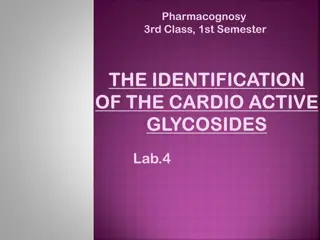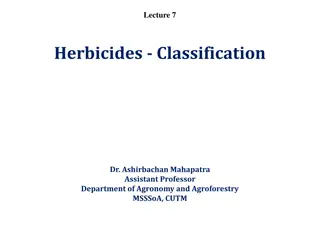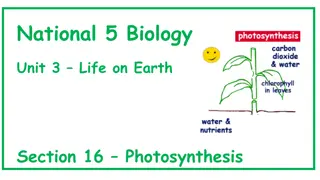Understanding Chemotaxonomy: Classification of Plants Based on Chemical Constituents
Chemotaxonomy, presented by Dr. R. P. Patil, explores the scientific investigation of the chemical characters in plants for taxonomy and phylogeny studies. It involves classifying plants based on their chemical constituents and molecular characteristics. Principles, methods, and importance of chemotaxonomy are elaborated, emphasizing the role of compounds like flavonoids, terpenoids, alkaloids, and more in plant classification. The relationship between plants is predicted by similarities in their chemical substances, aiding in identifying and arranging taxa in a natural plant system.
Download Presentation

Please find below an Image/Link to download the presentation.
The content on the website is provided AS IS for your information and personal use only. It may not be sold, licensed, or shared on other websites without obtaining consent from the author. Download presentation by click this link. If you encounter any issues during the download, it is possible that the publisher has removed the file from their server.
E N D
Presentation Transcript
Chemotaxonomy Presented by Dr. R. P. Patil Professor & Head Department of Botany Deogiri College, Aurangabad
Phytochemistry Chemical plant taxonomy or chemotaxonomy of plants may be defined as a scientific investigation of the potentialities of chemical characters for the study of problems of plant taxonomy and plant phylogeny. Plant taxonomy is the science of delimiting, describing and naming appropriately taxa and arranging them in a natural system of plants. The science of chemical taxonomy is based on classification of Plants on the basis of their chemical constituents related with the molecular characteristics.
Principles of chemotaxonomy were elaborated in the past century by A. P. De Candolle1 and by Geshoff. De Candolle put forward two postulates: (i) Plant taxonomy will be the most useful guide to man in his search for new industrial and medicinal plants; (ii) Chemical characteristics of plants will be most valuable to plant taxonomy in the future.
Chemotaxonomy includes: (i) Investigation of pattern of the compounds existing in plants, (ii) Investigation pattern of the compounds in plant parts likes bark, wood, Leaves, roots etc. Basic characters as evidence come from: (i) Flavonoids, (ii) Terpenoids, (iii) Carotenoids, (iv) Polysaccharides, (v) Alkaloids, (vi) Aminoacids, (vii) Fattyacids, (viii) Aromatic compounds, and (ix) C3-C4photosynthesis etc.
Chemotaxonomy is the classification of plants based on the chemical constituents in plants. It is assumed that the relationship between various types of plants can be predicted based on the similarity in the chemical substances present in them. Compounds that belong to the category of secondary metabolites and miscellaneous substances are of great values in identifying such relationships between plants and their classification. Chemical substances of low molecular weight such as the alkaloids, flavonoids, terpenoids, carotenoids, aromatic compounds etc. are some of them.
Principles of chemotaxonomy : Principles of chemotaxonomy i.e. contains their molecular characteristics. The same type of metabolites can be the product of two quite different pathways. Different plants sometimes contain secondary constituents belonging to different classes of compound but biosynthetically appear to be same.
Chemotaxonomic studies include the investigation of the pattern of compound occurring in the plant and preferentially in all various individual parts of plant such as the bark , wood, leaves , root, cuticles and seed. Such integrated investigations are necessary in order to obtain really convincing evidence for the relationship of plants. Before any important conclusions are drawn about the presence or absence of a particular compound adequate sampling of a large number of members of the species at different stages of development and growing in different environment should be made.
Mentzar (1966) provided biogenetic classification on the basis of natural relationships between various constituents. Micromolecules: (a) Primary metabolites (Organic acid, Amino acid, Sugar, Chlorophyll) present in each plant (b) Secondary metabolites (Alkaloids, Terpenoids, phenols, Specific Glucosidsetc.,) present in plants. Macromolecules: Chemicals for various functions Semantides (DNA, RNA, Protein etc.) Non- semantides (Starch, cellulose etc.) Primary metabolites: (i) These are compounds present in vital metabolic pathways. (ii) They are universal in distribution. (iii) They are of little taxonomic value. Among the Amino acids the distribution of single amino acids restricted e.g., Lathyrus martinus has protein which is absent in other species of Lathyrus. Lipids: Members of Asteraceae lack unsaturated lipids. Lipids are heterogenous group present in storage organs. It depletes in dark. (1) Linolenic rich seeds e.g., Rhamnaceae. (2) Linoleic rich seeds e.g., Juglans, Liliac etc. Oleic and Palmitic rich e.g., Acanthaceae, Annonaceae, Malvaceaeetc. Pigments: Chlorophyll and carotenoids are fat soluble Biloproteins and Anthocyanins are soluble in water. Anthocyanins and Betalins never coexist. Betalins are low molecular weight substances. Betacyanin gives purple colourand Betaxanthin gives yellow colour. Phytochemistry can supply data of use to the taxonomists. It is mainly based on the supposition that related plants will have a similar chemistry e.g., in Pinus every species has different type of terpentine. In Lichen chemical methods are largely used for the identification of genera an species.
Alkaloids : Alkaloids are compounds, containing heterocyclic nitrogen, basic character and complex molecular structure. Such compounds are restricted to plant kingdom. True alkaloids have a nitrogen-containing nucleus derived from biogenetic amine. Proto alkaloids derived from amino acids, but lack a heterocyclic ring. Natural protoalkaloids are usually simple amines e.g. ephedrine , mescaline. Some times they may be precursor of true alkaloids. Pseudo alkaloids biologically unrelated to amino acids. Most of them derived from- terpenes, sterols , nicotinic acid or purines.
Occurrence and Distribution: Occurrence and Distribution Higher plants particularly in the dicotyledons ,abundance in the Angiosperms families Apocynaceae, Papaveraceae, Ranculaceae, Rubiaceae, Rutaceae, Solanaceae, but less frequent in lower plants and fungi. In plants, alkaloids, due to their basic nature, generally exist as a salt of organic acid like, oxalic acid, citric acid, malic acid,, tartaric acid, tannic acid etc. Some alkaloids like narceine and nicotine are occurring free in nature. A few alkaloids occur as glycoside of sugars like glucose, rhamnose, and galactose. E.g. alkaloids of solanum and veratrum groups as amides (Piperine), as esters (Atropine, Cocaine) of organic acid.
Definition- (Alkaloids proper) Alkaloids are more or less toxic substances which act primarily on CNS. They have a basic character, contain heterocyclic nitrogen, and are synthesized in plants from amino acid and or their immediate derivatives . They are of limited distribution in plant kingdom. But such definition excludes a number of nitrogen containing plant constituents, which are normally thought as alkaloids. E.g. Biological amines like Ephedrine,Hardenine, Betain ,Cholin, Muscarine . All such alkaloids are separately referred as protoalkaloids or biological amines or amino alkaloids.
Ricinine is only alkaloid in Ricinuscommunisand Genitianine only alkaloid in Gentianaceae, that s why these two bases have been kept outside the class of true alkaloids. Some examples of alkaloid distribution and significance in taxonomy- Alkaloids are not universally accumulated by plants; some families are rich in alkaloidal species, such as Berberidaceae, Leguminosae, Solanaceae, Rutaceae, Rubiaceae, Compositae, Liliaceae and Orchidaceae Papaveraceae is rich in isoquinoline alkaloids Legumes are rich in lupin alkaloids Solanaceae is rich in tropanealkaloids Rubiaceae is rich in quinoline alkaloids Some alkaloids are restricted to only very certain plants e.g. Morphine i s restricted to P. somniferum Coniine is restricted to umbeliferous sp. Strychnine is restricted to strychnos species
Flavonoids Present in lvs,flr,frt.Defence mechanism. These are phenolics glycosides consisting of two benzene rings linked with heterocyclic pyrane ring. Classification: Glycoflavones: Chara,ferns,,, Flavonones: Apiginin, Levtolin. Flavonones: Naringinin. Isoflavones: Orobol Flavanols: Kaepferol, Quercetin. Anthocyanidins: Cyanidin, delphinidin. Chalcone: Butien Aurone: Sulphuretin.
Terpenoids Terpenoids ( isoprenoids ) , a subclass of the prenyllipids (terpenes, prenylquinones, and sterols), represent the oldest group of small molecular products synthesized by plants. During the 19th century, chemical works on turpentine led to name "terpene" the hydrocarbons with the general formula C 10 H 16 found in that complex plant product. These terpenesare frequently found in plant essential oils. They are universally present in small amounts in living organisms, where they play numerous vital roles in plant physiology as well as important functions in all cellular membranes. carotene is present in all green cells. Terpenoid, glycosides (cardiac glycosides) are present in Apocynaceae, Liliac, Moraceae etc. Monoterpenesare also known as essential oils. It depends on odors and essence etc. e.g., Lamiaceae, Apiaceae, Rutaceae etc. Sesquiterpene Lactones is a group of bitter tasting compounds. Out of 1400 in Asteraceae 1340 are present. Cronquist has shown evolution of Asteraceae on this basis i.e., Rubiales Dipsacales Asteraceae, rather than through Campanulaleswhere Lactones are altogether absent.
Terpenoids are extraordinarily diverse but they all originate through the condensation of the universal phosphorylated derivative of hemiterpene, isopentenyl diphosphate (IPP) and dimethylallyl diphosphate (DMAPP) giving geranyl pyrophosphate (GPP).
Classification Terpenes are hydrocarbons: Hemiterpenoids , 1 isoprene unit (5 carbons) Monoterpenoids , 2 isoprene units (10C) Sesquiterpenoids , 3 isoprene units (15C) Diterpenoids , 4 isoprene units (20C) Sesterterpenoids , 5 isoprene units (25C) Triterpenoids , 6 isoprene units (30C) Tetraterpenoids , 8 isoprene units (40C) Polyterpenoid with a larger number of isoprene units Terpenoids can also be classified according to the number of cyclic structures they contain.
CAROTENOIDS: :The nature of these compounds was discovered during the 19th century. In 1831, Wachen RoderH . proposed the term "carotene" for the hydrocarbon pigment he had cristallized from carrot roots . Berzelius J. called the more polar yellow pigments extracted from autumn leaves "xanthophylls" and Tswett M. , who separated many pigments by column chromatography, called the whole group "carotenoids" . Carotenoids consist of eight isoprenoid units joined in such a manner that the arrangement of isoprenoid units is reversed at the center of the molecule so that the two central methyl groups are in a 1,6-position relationship and the remaining non-terminal methyl groups are in a 1,5-position relationship. They are, by far the predominant class of tetraterpenes. They may be also classified in the terpenoids.
Steroids In plant they serve the role of water proof, present in cutin. It comprise a group of cyclical organic compoundswhose basis is a characteristic arrangement of seventeen carbon atoms in a four-ring structure linked together from three 6-carbon rings followed by a 5-carbon ring and an eight-carbon side chain on carbon 17 (illustration on right). These rings are synthesized by biochemical processes from cyclization of a thirty- carbon chain, squalene, into lanosterol orcycloartenol.
Ieridoid Compounds: These are bitter in taste e.g., monoterpenoids, Cyclopentanoids, Lactones etc. These are present in over 50 families of Sympetalae. Dahlgren kept all of them together e.g., Cornaceae, Scrophulariaceae, Gyrostemonaceae etc. Asperuloside is present in Rubiaceae and Buddlejaceae. Buddlejaceae is a new family. It is kept near Scrophulaniceae instead of Loogaviaceae. In Lamiaceae plants with binucleate tricdpate pollen have Tridoid compound and are resistant to fungal infections.
Phenolics: Biflavonoids: It is one of the best examples of secondary pigments present in flowers. These secondary pigments (Phenolics) are exclusive in nature (betalins). The presence of anthocyanin or betalins is not a single character but represents a set of characters involving genera. There is no interconversion of secondary metabolites. Phenolic compounds fall into a general class called Flavonoids. All contain characteristic flavonoid C15nucleus. Most flavonoids are present in vacuole of plant cell. Phenoliccompounds are inert end products of metabolism. Biflavonoidscontain 2 flavonoid and glycones linked by a carbon-carbon (C-C) bond. These are primitive and are found in most of the Gymnosperms. Four woody genera of angiosperms are known to contain biflavonoids e.g., Viburnum (Caprofoliaceae), Garcinia (Guttiferae), Heuea (Euphorbiaceae) and Casuarina (Casuarinaceae). The presence of biflavonoids in Casuarinasupport the family to be primitive as the earlier workers suggested and not like Cronquist and Takhtajan who considered this family as advanced but reduced. The flavonoid pattern in monocots and dicots does not differ much except the presence or absence of ellagicacid.
Raphides: Needle like crystals of Ca-oxalate arranged parallel to the bundles are found in families like Balsaminaceae, Onagraceae and Rubiaceae in Dicots and Orchidaceae in Monocots. Trapa member of Onagraceaewhich does not contain raphides and since been separated into a new family Trapaceae. Silica: Silica is generally present in member of Arecaceae (Palmae) and Poaceae (Gramineae). Metcalfe (1960) reported 20 types of silica bodies in the epidermal cells of leaves and found them of taxonomic significance. Gypsum Crystals of gypsum are reported in the members of Tamaricaceae and some members of Capparidaceae and Asteraceae. It is not found in members containing Ca-oxalate crystals.
Aminoacids Essential Nonessential Histidine Alanine Isoleucine Arginine* Leucine Asparagine Lysine Aspartic acid Methionine Cysteine* Phenylalanine Glutamic acid Threonine Glutamine* Tryptophan Glycine Valine Pyrrolysine* Proline* Selenocysteine* Serine* Tyrosine*























